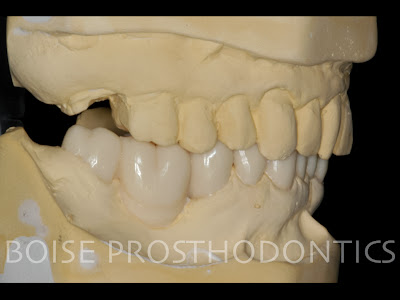This patient had recently been treated with new maxillary and mandibular removable complete arch dental prostheses. A couple months post insertion, the patient reconsidered the mandibular implant option originally presented prior to starting treatment and requested a two implant mandibular overdenture. The pictures below share the process of planning for the implant placement and eventually converting his existing mandibular complete denture into a two implant overdenture. The existing prostheses were in excellent condition.
The original mandibular prosthesis was duplicated in clear ortho-jet acrylic resin. The duplicate was then used to identify the amount of bone reduction needed to provide about 16 mm of prosthetic space (this amount of space was requested in order to provide adequate prosthetic space for a future fixed detachable prosthesis). Also, the lingual flange was removed lingual to the anterior and premolar teeth to allow the remaining buccal/labial portion of the guide to visualize the buccal extent to which the implants may be placed. Radiographic spheres were also embedded in the guide to allow the surgeon to obtain a panoramic radiograph and calculate the magnification error.

This photo demonstrates the healed tissue around the implants with the appropriate size locator abutments in place. NOTE: post implant placement the patient's existing complete denture was left out for about a week. It was then relined with a soft intraoral denture re-lining material. The soft liner was replaced about every month for the next three months. The implants were uncovered at three months post placement and straight walled healing abutments were inserted. Two weeks after uncovering the implants the tissue was measured for proper locator abutment height.
The locator abutments were inserted, hand tightened, and the processing housings were placed onto the abutment with the white silicone gasket in place. The intaglio surface of the current complete denture was uniformly relieved about 1 mm to allow for adequate space for a reline PVS pick-up impression. NOTE: prior to making the impression the current OVD was identified and recorded. The record was used to ensure the OVD was maintained while making the impression.
The impression was then sent to the lab for a lab processed hard reline. Once the reline was complete it was inserted into the patient's mouth. NOTE: the locator abutments were removed and the healing abutments were re-inserted into the patient's mouth. Appropriate adjustments were made to the denture (PIP, sorensons paste, and articulation) and the patient took the denture home and wore it for 24 hours. The following day the patient returned and appropriate adjustments were made to ensure proper fit and articulation of the denture. The locator abutment were re-inserted and the female metal housings with the black processing retention were inserted with the silicone white gaskets in place. The re-lined denture was then inserted into the mouth and relieved if necessary over the housing areas to ensure complete seating of the denture could be achieved. NOTE: OVD was recorded prior to picking up the housings in the mouth to ensure OVD would not be changed during the housing pick up process. Fast curing acrylic resin was then lightly placed into the relieved areas of the denture and inserted into the patient's mouth and lightly held in place until cured. NOTE: the housings need to be dry prior to inserting the denture
The prosthesis is remove and flash acrylic is removed. The black plastic retentive inserts are removed and the appropriate retentive inserts are placed into the metal housings. It was then tried back into the patient's mouth to verify complete seating and the patient's ability to insert and remove. The occlusion was then checked and adjusted.





























































